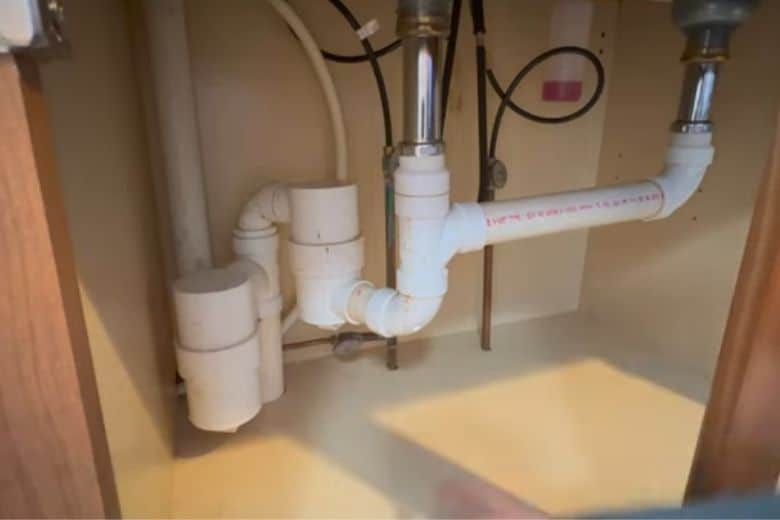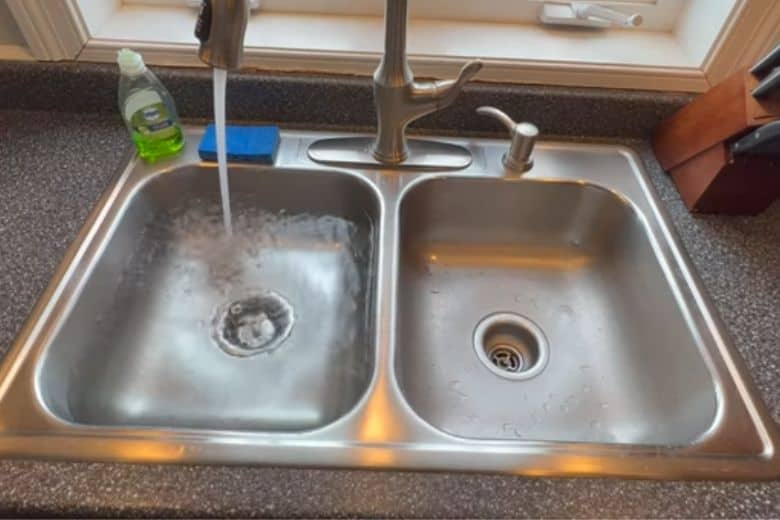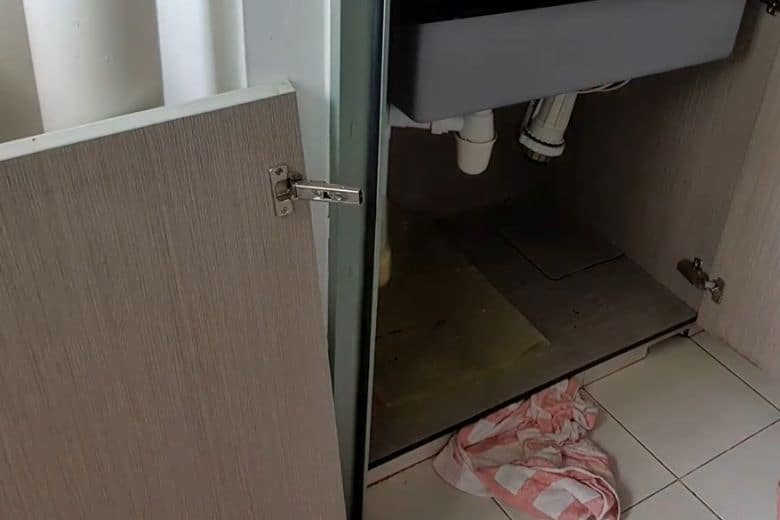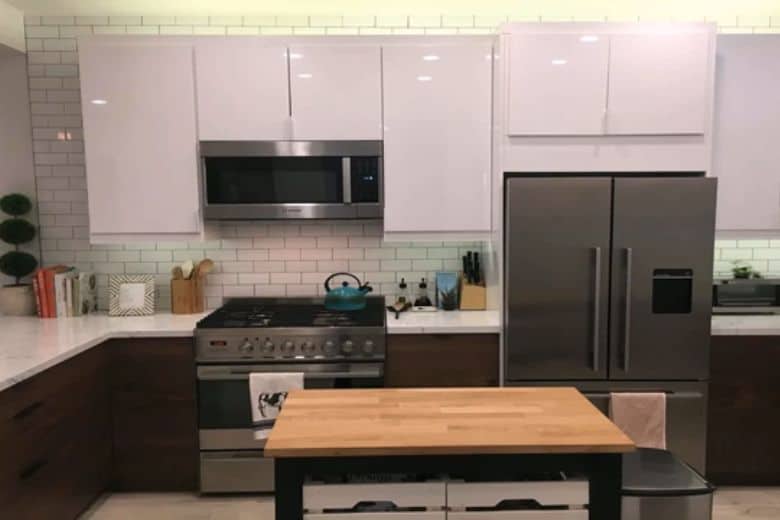The term “airlock” indicates the presence of air pockets inside the pipe that impede water flow. Typically, this occurs when the drain pipe has not been cleared for a prolonged time. Consequently, gas accumulation and imbalanced air pressure within the pipe generate endless air bubbles.
However, encountering air bubbles in your kitchen sink drain is surely a painful and dreadful experience. The water may be stagnant, refusing to flow through the drain and instead gathering on the surface of your sink. Not only does it create an unsightly and unappealing sight, but it also poses a severe threat to hygiene and cleanliness.
Then what do you do to solve the issue?
Don’t worry; to solve the airlock issue in your kitchen sink drain, you must know how to fix airlock in kitchen sink drain. To start, you need to open the kitchen sink drain and inspect its internal components to detect and rectify the airlock. The root cause of the airlock within the kitchen sink drain is air pressure and venting imbalance. Therefore, one must create a forceful vacuum within the drain to expel the airlock and restore the efficient flow of the drain.
Why Airlocks Happen Inside Drain and Pipes
Airlocks occur when air bubbles or pockets form inside the pipe and drain, causing a hindrance to water flow and resulting in clogging. It obstructs water movement, leading to water buildup over the kitchen sink, which may overflow onto the floor.
Airlocks are more prevalent in hot water drains as the small hot water tank lacks sufficient pressure to expel the air pockets, unlike cold water drains, which receive water directly from the main water tank and have enough pressure to eliminate air bubbles.
Fortunately, resolving airlocks in drains is a relatively easy task. Typically, you can fix the airlock by linking the cold-water line of your kitchen sink with the hot water, which increases the water pressure and tears apart the air bubbles, thus eliminating the lock.
This results in a smooth water flow through the drain, allowing it to function correctly.
How to Fix Airlock in Kitchen Sink Drain (4 Workable Steps)
Now that we have established the causes of an airlock in the kitchen sink drain let us move on to fixing it. Is it necessary to contact a plumber for assistance? The answer is no. You can quickly and easily remove the airlock from your kitchen sink without the help of a plumber.
You can eliminate the airlock within minutes by acquiring a few essential items. You will need the following tools. Have a look.
- A screwdriver
- Drain snake and augers
- An adjustable wrench
- A flashlight
Step 1: Check the Drain
The initial step in addressing the airlock in the kitchen sink drain is to inspect the drain thoroughly. Begin by opening the kitchen faucet and checking if water still flows through the drains. If you observe that water has stopped running through the drain, take a flashlight and direct it towards the drain pipe to inspect it closely.
Check if the pipe is obstructed or not. If no obstructions are inside the drain, but water still fails to flow through it, then an airlock is likely the culprit.
Step 2: Try Using Cold Water
After confirming the airlock in the sink drain, you can move forward to fix it. To do so, you must run cold water to increase the water pressure and eliminate the air bubbles inside the drain.
However, you need to inspect your kitchen sink faucet system beforehand. Is it a dual-handle faucet with separate hot and cold-water controls? Or a single-handle faucet that controls both hot and cold water?
Because each category has to deal with differently, you can proceed with the following procedures after examining the sink faucet mechanism.
- For the dual-handle kitchen sink faucet system, begin by running the hot water. Then, turn on the sink faucet responsible for cold water. Because cold water flows directly from the main tank, it has higher pressure and will push through the hot water to enter the sink drain. With increased pressure, it will allow the cold water to displace any trapped air pockets or bubbles and eliminate the airlock in the kitchen sink drain.
- If your kitchen faucet is single-handle and mixes hot and cold water, you will need to take a different approach. Place an absorbent material, such as a clean cloth, at the spout of the kitchen sink faucet. By blocking the cold-water spout, the water will flow through the hot-water spout instead. Let the cold water run through the sink drain and wait a few minutes for it to work. If everything goes smoothly and there are no clogs, the airlock in the sink drain should be eliminated.
After trying this solution, in case, you continue to experience airlocks in the sink drain; the issue may be located within the P–trap. You must remove the sink drain and address the P-trap directly in that circumstance.
Step 3: Work with the P-trap
The P-trap in the kitchen sink drain connects the drain and the main sewer line. It prevents gases and odors from the sewer line from entering the main drain and living space. While it is uncommon, airlocks can still occur within the P-trap.
To proceed, turn off the water faucet and your home’s main water supply line. Use a screwdriver to remove the sink strainer and then utilize a drain auger for clearing any blockages in the sink drain and P-trap. It’s crucial to ensure that the drain auger or snake is long enough to reach both the P-trap and the entire sink drain.

If the previous step does not resolve the issue, disassemble the P-trap using a screwdriver and adjustable wrench. As you detach and open it, any air bubbles trapped within should be automatically released into the open air. Additionally, you can use a sink auger to clear any clogs within the sewer line.
By following these steps, you should be able to eliminate any airlocks from your kitchen sink drain. If you still experience issues with water not running through the drainpipe, you may need to inspect the main sewer line where the water drains out.
Precautions to Take While Fixing an Airlock in Your Kitchen Sink Drain:
- Remember to turn off the water supply before beginning any work.
- Always use proper safety equipment, such as gloves and eye protection.
- Follow the manufacturer’s instructions when using any tools or equipment.
- Do not force anything through the drain, as this could cause damage.
- Be careful when disassembling the P-trap or any other sink drain parts to avoid damaging any components.
- If you are uncomfortable performing the repair, consider seeking the help of a professional plumber.
Frequently Asked Questions
Do airlocks clear themselves?
Answer: Sometimes, airlocks in a kitchen sink drain can clear themselves. It can happen if water continually runs through the drain, and the air pockets eventually work themselves out. However, if the airlock is particularly stubborn or if it is causing significant issues with water flow, it is best to take proactive measures to eliminate it.
How do I get rid of the air in my sink drain?
Answer: First, turn the water supply line off for approximately 30 minutes to let the sink drain dry out completely. Next, turn on the water supply line and run cold water through the kitchen sink faucet and down the drain to eliminate any trapped air pockets.
How long will the airlock bubble?
Answer: The duration of an airlock bubble in a kitchen sink drain can vary depending on different factors, such as water pressure and the size of the trapped air pocket. It is difficult to predict how long an airlock bubble will last, as it can clear out quickly or persist for an extended period. In that case, take proactive measures, such as running cold water or using a drain auger, to eliminate the airlock bubble as soon as possible.
Can a sink drain get air locked?
Answer: A sink drain can become airlocked quite quickly. When there is an imbalance of air for an extended period, the trapped air can reduce the water flow in the sink drain. It is crucial to address airlocks promptly to prevent overflow in the kitchen sink.
Conclusion
Airlocks are common in plumbing systems and can also occur in the kitchen sink drain. If you’re experiencing this problem, the guidelines we’ve provided on how to fix airlocks in kitchen sink drain should be helpful. You don’t need a plumber to resolve the issue, as it’s a simple DIY plumbing project.
Paul Newman is a blogger who writes about plumbing and home improvement. Over the past 20 years, I have worked as a plumber. My passion is to share my knowledge and experience with others to improve their homes.




